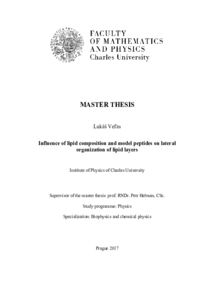Influence of lipid composition and model peptides on lateral organization of lipid layers
Vliv lipidového složení a modelových peptidů na laterální organizaci lipidových vrstev
diploma thesis (DEFENDED)

View/
Permanent link
http://hdl.handle.net/20.500.11956/85710Identifiers
Study Information System: 174617
CU Caralogue: 990021431040106986
Collections
- Kvalifikační práce [11363]
Author
Advisor
Consultant
Šachl, Radek
Referee
Malínský, Jan
Faculty / Institute
Faculty of Mathematics and Physics
Discipline
Biophysics and Chemical Physics
Department
Institute of Physics of Charles University
Date of defense
8. 6. 2017
Publisher
Univerzita Karlova, Matematicko-fyzikální fakultaLanguage
English
Grade
Excellent
Keywords (Czech)
liposomy, GUV, FRET, FLIM, domény, separace fázíKeywords (English)
liposomes, GUV, FRET, FLIM domains, phase separationOxidované fosfolipidy (OxPL) sa nachádzajú v živých organizmoch kvôli oxidatívnemu stresu. Napriek tomu, fyziologická funkcia OxPL nie je doposiaľ úplne známa. Prítomnosť OxPL bola preukázaná v množstve zápalových ochorení akým je ateroskleróza či neurodegeneratívnych ochorení akými sú Parkinsonova a Alzheimerova choroba. V tejto práci prezentujeme vplyv dvoch OxPL na laterálnu heterogenitu modelovej lipidovej membrány. Konkrétne sme skúmali vplyv 1-palmitoyl-2-(5'-oxo-valeroyl)-sn-glycero-3-fosfocholínu (POVPC) a 1-palmitoyl-2-glutaryl-sn-glycero-3-fosfocholínu (PGPC) na formáciu nanodomén prítomných v obrích unilamelárnych vezikulách obsahujúcich 1,2-dioleoyl-sn- glycero-3-fosfocholín (DOPC), cholesterol a sfingomyelín. Len niekoľko málo techník je schopných detegovať nanometrové domény nachádzajúce sa v membráne s vysokým rozlíšením. Časovo rozlíšený Försterov rezonančný prenos energie (TR-FRET) v kombinácii s Monte Carlo (MC) simuláciami poskytuje silný nástroj nie len na detekciu laterálnych heterogenít ale aj ich charakterizáciu s rozlíšením 2 nm. V prítomnosti oboch skúmaných OxPL bol pozorovaný výrazný vplyv na veľkosť nanodomén a v prípade PGPC, ktorý obsahuje karboxylovú skupinu bola detegovaná formácia väčších nanodomén v porovnaní s POVPC, ktorý obsahuje aldehydovú skupinu. MC simulácie boli...
Oxidized phospholipids (OxPLs) are known to be present in living organisms due to oxidative stress. However, the physiological function of OxPLs is still not fully understood. They have been shown to be present in many inflammatory diseases such as atherosclerosis and neurodegenerative diseases like Parkinson's and Alzheimer's disease. In this work we present the influence of two truncated OxPLs on the lateral heterogeneity of a model lipid membrane. Specifically, we studied the effect of 1-palmitoyl-2-(5'-oxo-valeroyl)-sn-glycero-3- phosphocholine (POVPC) and 1-palmitoyl-2-glutaryl-sn-glycero-3-phosphocholine (PGPC) on the formation of nanodomains present in giant unilamellar vesicles containing 1,2- dioleoyl-sn-glycero-3-phosphocholine (DOPC), cholesterol and sphingomyelin. Only few techniques are capable of detecting nanometer-sized domains in the membrane with high resolution. Time resolved Förster resonance energy transfer (TR-FRET) combined with Monte Carlo (MC) simulations provide a strong tool not only to detect lateral heterogeneities but also characterize them with the resolution of 2 nm. Profound effects on the nanodomain size were observed in the presence of both studied OxPLs and differences were detected, as PGPC with a carboxylic group drives formation of larger nanodomains than POVPC...
